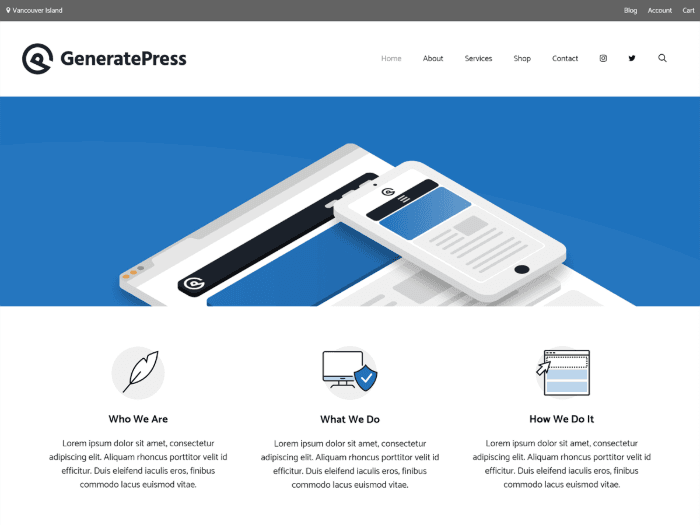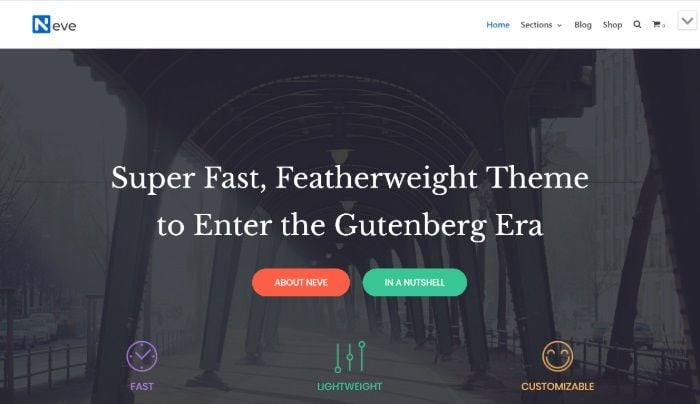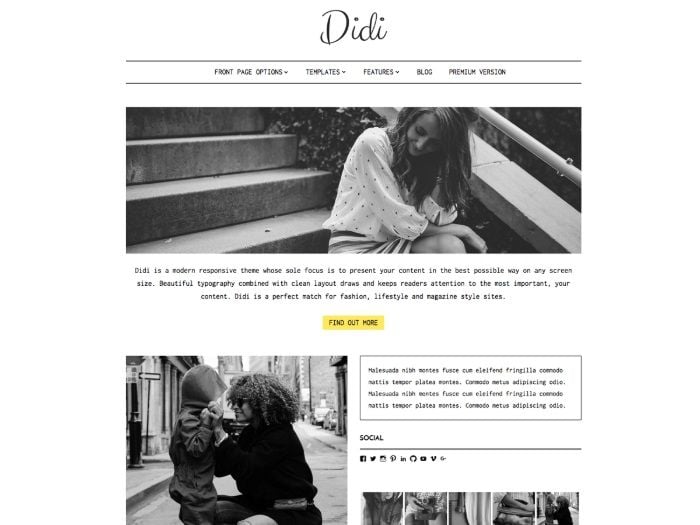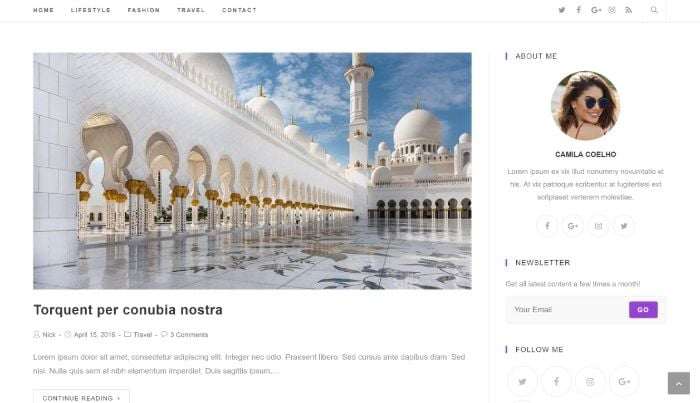If you’re starting your blog on a budget, a free WordPress theme is a great way to keep costs down.
The problem?
There are literally thousands of free WordPress themes to sort through. And when you search for guidance on Google, you’re greeted with articles offering dozens (or hundreds) of free WordPress theme options.
Let’s be honest:
You don’t need a list of dozens (or hundreds) of free WordPress themes. There’s not enough time in the day to review them all, and most of them sound the same anyway.
No, what you need is a small list of themes that have been vouched for and vetted by people who know what they’re talking about.
And you need that list to be broken down in a way that makes it easy for you to choose a great theme that best fits your needs.
In short, you need the post you’re reading right now.
We asked 11 influential WordPress experts and bloggers the following, open-ended question:
“What is the best free WordPress theme for bloggers?”
They were allowed to pick up to two themes.
Here are the results:
1. Astra by Brainstorm Force
A Look at Astra (in 50 Words or Less)
Astra (affiliate link) is a popular multipurpose theme that offers a lightweight, SEO-friendly foundation that you can build into your own unique design via a set of simple, customization options. No coding is required.
The TL;DR for Astra
7 Votes
Of our 11 experts, 7 chose Astra in our survey.
1+ Million Active Installs
There are more than 1 million active installations of the Astra theme.
5.0 Rating
Users have given Astra an average rating of 5.0 out of 5.0 stars.
What Our Experts Say About Astra
[su_testimonial name=”Brad Morrison” photo=”https://smartblogger.com/wp-content/uploads/2019/05/brad-morrison.jpeg” company=”Founder of GoWP” url=”https://www.gowp.com” target=”blank” border=”yes” class=””] The Astra theme is perfect for someone who’s getting started with blogging. Not only can you easily control the look and feel of the blog through the settings in the WordPress Customizer; but you can also import a complete starter site for free using the Astra Sites plugin. This can get you up and running in minutes.[/su_testimonial] [su_testimonial name=”Colm Troy” photo=”https://smartblogger.com/wp-content/uploads/2019/05/colm-troy.jpeg” company=”Co-founder of Create and Code” url=”https://createandcode.com” target=”blank” border=”yes” class=””] I’m a big fan of keeping things as simple and as fast as possible and the default “out of the box” Astra experience aligns with my own ethos perfectly. As a theme author I was pleasantly surprised at how many sensible defaults they had adopted meaning I think I spent less time setting this blog up than any other in recent memory!
[/su_testimonial] [su_testimonial name=”Nick Adams” photo=”https://smartblogger.com/wp-content/uploads/2019/05/nick-adams.jpg” company=”COO at WP Buffs” url=”https://wpbuffs.com” target=”blank” border=”yes” class=””] The free version comes with a lot of flexibility, it’s very well coded and the team behind it is great at support. It also works perfectly with WordPress’ new block editor as well as Beaver Builder and the Elementor page builder, so it’s a great option no matter how you build your content.
[/su_testimonial] [su_testimonial name=”Adam Connell” photo=”https://smartblogger.com/wp-content/uploads/2019/05/adam-connell.jpg” company=”Founder of Blogging Wizard” url=”https://bloggingwizard.com” target=”blank” border=”yes” class=””] Sure, [Astra] may not be the snazziest theme out there in it’s “out of the box” form, but it’s lightweight and gives you a great platform to build upon.
Want to get started right now? Install the theme, activate, make a few tweaks and get your blog out there. So, you can start writing today! Then, once you’re ready, you can grab the add-ons to the theme and customize it further.
[/su_testimonial]
Last One:
[su_testimonial name=”Harsh Agrawal” photo=”https://smartblogger.com/wp-content/uploads/2019/05/harsh-agrawal.jpg” company=”Founder of ShoutMeLoud” url=”https://www.shoutmeloud.com” target=”blank” border=”yes” class=””] Astra is one WordPress theme that has been on my radar for a while. We are actually moving ShoutMeLoud from Genesis to Astra for a few reasons:- The code is super clean and it’s one of the well-developed themes.
- With over 200,000+ installs, it is one of the best free WordPress themes in the repository.
- It works with Elementor Pro, LearnDash, EDD and few other popular extensions that we use all the time.
[/su_testimonial]In case you missed it, Harsh Agrawl is moving his website to Astra, so his comments are more of a testimonial than a review. That’s how big a fan he is of the theme.Astra also received votes from Karol Krol and Daan Tol. We’ll have more from them later.Key Features of Astra
- Responsive WordPress theme with numerous page layouts
- Lots of customization options in the native WordPress Customizer (these let you control your theme’s design without needing any special technical knowledge)
- Multipurpose – use it for any type of site, blogs included
- Lightweight, responsive layouts for mobile devices
- Works great with drag-and-drop page builders like Elementor (affiliate link) or Beaver Builder (learn more in our in-depth breakdown of the best Elementor themes)
- One of the most popular free WordPress themes, with more than 200,000 active installations
- Compatible with the Gutenberg block editor
- SEO optimized for search engines
- Translation ready
- User-friendly theme with intuitive dashboard options
- Custom widgets and widget areas, 700+ Google fonts, social icons, custom backgrounds, and numerous color options
- WooCommerce support for business websites with e-commerce stores
- Active Facebook discussion group to learn tips and tricks
- Retina ready
- WPML compatible
- 5-star rating on over 1,600 reviews at WordPress.org
- Perfect for those looking for a free, stable WordPress blog theme
Final Thoughts on Astra
If you want a free, lightweight WP theme that excels at customization and performance, Astra is a great choice.
2. Writee by Scissor Themes

A Look at Writee (in 50 Words or Less)
Writee is a clean theme option that puts the focus on your writing, along with a spot for a bold, full-width featured image.
The TL;DR for Writee

3 Votes
Of our 11 experts, 3 chose Writee in our survey.

10k Active Installs
There are more than 10,000 active installations of the Writee theme.

4.7 Rating
Users have given Writee an average rating of 4.8 out of 5.0 stars.
What Our Experts Say About Writee
[su_testimonial name=”Katie Keith” photo=”https://smartblogger.com/wp-content/uploads/2019/05/katie-keith-photo.jpg” company=”Co-founder of Barn2 Media” url=”https://barn2.co.uk” target=”blank” border=”yes” class=””] My recommended free WordPress theme for bloggers is Writee by Scissor Themes. This theme has a clean and modern design that is simple enough to work for all sorts of blogs. It’s very easy to set up, making it ideal for beginners. It comes with a range of widgets that bloggers will need, such as an ‘About Me’ widget and social widget.
[/su_testimonial] [su_testimonial name=”Devesh Sharma” photo=”https://smartblogger.com/wp-content/uploads/2019/05/devesh-sharma.jpg” company=”Founder of WPKube” url=”https://www.wpkube.com” target=”blank” border=”yes” class=””] Writee is a free blogging theme found in the WordPress Repository, meaning it was built using the highest coding practices. It will work for all types of blogging sites, is easy to customize using the Live Customizer, and can easily be translated into the language of your choice if needed. Though there is room for more advanced customizations when it comes to the layout, sidebars, and navigation menus, Writee is perfect out-of-the-box and is suitable for even the most novice of bloggers.
[/su_testimonial] [su_testimonial name=”Charlie Livingston” photo=”https://smartblogger.com/wp-content/uploads/2019/05/charlie-livingston.jpg” company=”Founder of aThemes” url=”https://athemes.com” target=”blank” border=”yes” class=””] There are a lot of excellent free blogging themes out there, but one standout is Writee by Scissor Themes. It has striking visuals, a lot of customization potential, and some other neat features.
[/su_testimonial]Key Features of Writee
- Responsive design with responsive themes
- Clean, minimal looks
- Bold featured images (that’s where the “striking visuals” come from)
- Multiple blog archive options – list or grid view
- Customization via the native WordPress Customizer
- Full-width or boxed slider
- WooCommerce integration compatibility for e-commerce stores
Final Thoughts on Writee
Writee is a great option if you want something that’s going to look great right out of the box. This contrasts with Astra and some of the other free WordPress themes on this list, where you’re expected to put in a little elbow grease to make them your own.
With Writee, you just activate it and start writing.
3. GeneratePress by Tom Usborne

A Look at GeneratePress (in 50 Words or Less)
GeneratePress is another popular option that shares the same philosophy as Astra. That is, it’s a lightweight chameleon that you can adapt to any niche or need.
In performance tests, GeneratePress usually ends up at the top of the pack, which is great if you want your blog to load fast. Beyond that, it also comes with over-the-top good support.
The TL;DR for GeneratePress

1 Vote
Of our 11 experts, 1 chose GeneratePress in our survey.

300k Active Installs
There are more than 300,000 active installations of the GeneratePress theme.

5.0 Rating
Users have given GeneratePress an average rating of 5.0 out of 5.0 stars.
What Our Experts Say About GeneratePress
[su_testimonial name=”Daan Tol” photo=”https://smartblogger.com/wp-content/uploads/2019/05/daan-tol.jpeg” company=”Owner of WPLift” url=”https://wplift.com” target=”blank” border=”yes” class=””] Tom Usborne (the owner/creator of GeneratePress) is very helpful on [the support forum]. I could solve all my problems just by searching in the support forum. He also gives some great tips for using plugins that go very well with his theme (Code Snippets, Simple CSS). This way of working kept my theme vanilla so that I can always update without having to worry. For a non-coder like me – that’s the dream.
[/su_testimonial]Key Features of GeneratePress
- Super lightweight and performance optimized (under 30 kb)
- Tons of customization options in the native WordPress Customizer
- Compatible with the Gutenberg block editor
- One of the best free responsive WordPress website themes, with a great mobile design
- Excellent code quality
- Integrates well with all major page builders, including Elementor and Beaver Builder
- WooCommerce plugin compatible for e-commerce stores
- 5-star rating on over 800 reviews at WordPress.org
Final Thoughts on GeneratePress
Like Astra, GeneratePress will look pretty basic when you first install it. However, the magic of this theme is the many options in the WordPress Customizer that let you build it into the exact look you want.
If you’re willing to put in some time, you can create the WordPress of your dreams, and it will all be powered by a lightweight, performance-optimized foundation.
Finally, as Daan mentioned, the theme’s developer, Tom Usborne, offers amazing support if you ever need a helping hand.
4. Neve by Themeisle

A Look at Neve (in 50 Words or Less)
Neve (affiliate link) is a lightweight multipurpose WordPress theme that’s optimized to work with the new WordPress block editor (also known as the Gutenberg editor). It’s also on the list of the most popular free WordPress themes at WordPress.org, which means that, although it’s new, it’s getting a lot of traction.
While you certainly can customize Neve to suit your needs, it’s actually an elegant theme right out of the box, and it also comes with a variety of pre-built demo sites that you can import with just a few clicks. This is great for users who want an online presence with minimal fuss.
The TL;DR for Neve

1 Vote
Of our 11 experts, 1 chose Neve in our survey.

100k Active Installs
There are more than 100,000 active installations of the Neve theme.

4.8 Rating
Users have given Neve an average rating of 4.8 out of 5.0 stars.
What Our Experts Say About Neve
[su_testimonial name=”Karol Krol” photo=”https://smartblogger.com/wp-content/uploads/2019/05/karol-krol.jpg” company=”Heads Content at Themeisle” url=”https://themeisle.com/blog/” target=”blank” border=”yes” class=””] If you’d rather get a theme that looks great out the box and simply works without necessarily needing to dive through various settings panels, use Neve. It gives you a modern, beautiful design that’s also built with performance in mind. Plus, it’s the top 10 most popular free theme in the official theme directory at WordPress.org. What more could you need?
[/su_testimonial]Key Features of Neve
- Responsive theme design
- Built to work well with the new WordPress block editor
- One-page design
- Customization options in the real-time WordPress Customizer
- Mega menu support
- Importable demo sites
- WooCommerce compatible for online shops
Final Thoughts on Neve
As Karol highlighted, Neve makes a great option if you want something that’s going to look great as soon as you install it. If you like the default looks, you can just install it and start writing. Or, if you want to switch things up, but don’t want to redesign things yourself, you can also import one of the pre-built demo sites by clicking a few buttons.
5. Reykjavik by WebMan Design

A Look at Reykjavik (in 50 Words or Less)
Reykjavik brands itself as a free business theme for WordPress, but it’s got a great look that can just as easily be adapted to blogging or other niches.
As the name suggests, you get a very “Nordic” feel to the styling.
(Basically, if you like Ikea, you’ll probably like this WordPress theme!)
The TL;DR for Reykjavik

1 Vote
Of our 11 experts, 1 chose Reykjavik in our survey.

3k Active Installs
There are more than 3,000 active installations of the Reykjavik theme.

5.0 Rating
Users have given Reykjavik an average rating of 5.0 out of 5.0 stars.
What Our Experts Say About Reykjavik
[su_testimonial name=”Marko Segota” photo=”https://smartblogger.com/wp-content/uploads/2019/05/marko-segota.jpg” company=”Co-founder of Anariel Design” url=”https://www.anarieldesign.com” target=”blank” border=”yes” class=””] Reykjavik is a fresh, lightweight theme that features minimalist style. It is therefore a great fit for blogging and portfolio type websites.
[/su_testimonial]Key Features of Reykjavik
- Responsive design
- Great-looking WordPress blog post layout with space for a full-width featured image
- Accessible by default – passes WCAG 2.0 level AA and Section 508 requirements
- Customization via the native WordPress Customizer
- One-click demo content import
- Compatible with all major page builder plugins
Final Thoughts on Reykjavik
Reykjavik is another option that will give you a great-looking site from the second you install it. The clean styling also does a great job of highlighting your content, and will satisfy your love of Nordic style more than an ALLEMANSRÄTTEN meatball.
(Those are the meatballs at Ikea, if you’re not familiar.)
Note: While the earlier screenshot highlights Reykjavik’s business-focused homepage, I’d recommend you click through to the demo because the blog page has a great full-width responsive layout that really puts the focus on your content. You can see one of the sample blog posts here.
6. Cali by aThemes

A Look at Cali (in 50 Words or Less)
With its focus on visual imagery, Cali makes a great option for fashion, lifestyle, travel, personal blogs, and anyone looking for a WordPress magazine theme.
Beyond its looks, Cali also builds in some other helpful features for bloggers, like a newsletter integration (via the MailChimp for WordPress plugin), dedicated spots for social media icons at both the top and bottom of your page, and space to bring in your Instagram feed (via the WP Instagram Widget plugin).
The TL;DR for Cali

1 Vote
Of our 11 experts, 1 chose Cali in our survey.

1k Active Installs
There are more than 1,000 active installations of the Cali theme.

3.0 Rating
Users have given Cali an average rating of 3.0 out of 5.0 stars.
What Our Experts Say About Cali
[su_testimonial name=”Charlie Livingston” photo=”https://smartblogger.com/wp-content/uploads/2019/05/charlie-livingston.jpg” company=”Founder of aThemes” url=”” target=”blank” border=”yes” class=””] (I) also recommend our own Cali theme. It has plenty of cool options for bloggers – including a posts carousel, a wide selection of fonts to choose from, and social media integration.
[/su_testimonial]Key Features of Cali
- Responsive design
- Full-width posts carousel at the top of the screen
- Lots of spots to showcase your featured images/visuals
- Customization via the native WordPress Customizer
- Built-in social follow buttons (two different locations)
- WooCommerce compatible for online stores
- Integrations for MailChimp for WordPress and WP Instagram Widget (the theme recommends that you install both of these plugins)
Final Thoughts on Cali
Cali’s a solid WordPress template for lifestyle, fashion, or travel blogs…or really just any niche with a heavy focus on imagery. Beyond that, it does a good job of integrating social media into its design, which, if you’re active on popular social media sites, is another big benefit to choosing this theme.
7. Didi Lite by Anariel Design

A Look at Didi Lite (in 50 Words or Less)
If you want something minimal that will put the focus on your strong words, Didi Lite is a great free option that has one of the simplest looks on this list. The theme offers plenty of white space and unique typography options that will help your site stand out.
As the “lite” in the name suggests, there’s also a premium version that you can purchase if you decide you’d like more layouts and a meatier theme customizer.
The TL;DR for Didi Lite

1 Vote
Of our 11 experts, 1 chose Didi Lite in our survey.

700+ Active Installs
There are more than 700 active installations of the Didi Lite theme.

4.5 Rating
Users have given Didi Lite an average rating of 4.5 out of 5.0 stars.
What Our Experts Say About Didi Lite
[su_testimonial name=”Marko Segota” photo=”https://smartblogger.com/wp-content/uploads/2019/05/marko-segota.jpg” company=”Co-founder of Anariel Design” url=”” target=”blank” border=”yes” class=””] Didi Lite is a modern blogging theme, built mobile first, that offers sleek layout and beautiful typography. With its minimalistic design it brings readers’ focus to what really matters: the content.
[/su_testimonial]Key Features of Didi Lite
- Responsive design
- Minimal looks with plenty of white space
- Multiple front page options to display your latest blog posts
- Beautiful typography
- Demo content
- Built to work well with Elementor (and other page builders)
Final Thoughts on Didi Lite
With its minimal design, Didi Lite makes a great option for both freelancers who focus on written content, as well as fashion or lifestyle blogs (because you also get the option to display large featured images).
It’s also another good option if you want a theme that looks “polished” as soon as you install it.
8. OceanWP by OceanWP

A Look at OceanWP (in 50 Words or Less)
OceanWP is another free theme that follows the chameleon principles of Astra and GeneratePress. Once again, that means it’s a flexible foundation that you can build into your dream blog theme.
Like Astra and Neve, OceanWP also offers some free demo sites that you can import if you don’t want to customize your design from scratch.
The TL;DR for OceanWP

1 Vote
Of our 11 experts, 1 chose OceanWP in our survey.

600k Active Installs
There are more than 600,000 active installations of the OceanWP theme.

4.9 Rating
Users have given OceanWP an average rating of 4.9 out of 5.0 stars.
What Our Experts Say About OceanWP
[su_testimonial name=”Daan Tol” photo=”https://smartblogger.com/wp-content/uploads/2019/05/daan-tol.jpeg” company=”Owner of WPLift” url=”” target=”blank” border=”yes” class=””] I like the set of options OceanWP has for the headers. It has so many well-designed options out of the box. Plus the free extensions are awesome. [The free extensions] offer you a lot of (customizable) control on your website.
[/su_testimonial]Key Features of OceanWP
- Responsive design
- Multipurpose and flexible looks
- Uses the native WordPress Customizer for customization
- Pre-built importable demo sites
- Offers a number of free extensions
- Lots of different header image options
- Built to work well with popular WordPress page builders
- WooCommerce compatible for small businesses with online shops
- Active on 300,000+ sites
- 5-star rating on over 2,100 reviews at WordPress.org
Final Thoughts on OceanWP
OceanWP has a lot of similarities to GeneratePress and Astra, but it’s a little more focused on offering design and functionality flexibility, rather than just acting as a lightweight canvas. For example, you’ll find official free extensions for social sharing, sticky headers, and more that you won’t get with Astra or GeneratePress.
Free WordPress Themes: Frequently Asked Questions
Before we wrap up, let’s look at a few common questions we hear from readers regarding free WordPress themes. Questions like:
1. Free WordPress Themes vs Premium Themes: Is There a Difference?
When it comes to free WordPress themes vs premium WordPress themes, there are a lot of misconceptions out there.
Have you seen people write stuff like “premium themes are coded better than free themes”? Or “premium themes offer better designs”? How about “premium themes load faster than free themes”? Or even “premium themes are more secure than free themes”?
As someone who makes his living in the WordPress space, let me tell you that none of that is true. It’s just impossible to make those generalizations based solely on a theme’s price tag.
Free themes are code.
Premium themes are code.
You can have perfectly coded free themes and poorly coded premium themes. You can have well-maintained free themes, and premium themes that haven’t been updated in years. And, of course, the opposite can also be true.
What’s more, many themes are both free and premium. For example, the Astra theme that came so highly recommended comes in both a free and a premium version, and the “core” theme is exactly the same between each. The code doesn’t suddenly become “better” when you crack open your wallet, right?
Long story short:
There’s not a single inherent difference between free themes vs premium themes and there’s no reason you need to feel compelled to use a premium WordPress theme.
So if you absolutely love a free WordPress theme, it comes from a quality developer who maintains it, and it does everything you need it to already, just use it and be happy!
That doesn’t mean premium themes have no benefits
If you noticed above, you’ll see I used phrases like “inherent difference.” That’s because I wanted to hedge my bets a little bit. 🙂
There is, of course, a reason why premium themes exist, and it might turn out that a premium theme actually is a better option for your unique situation, especially as your blog starts growing.
Even if you start with a free WordPress theme, here are some reasons to consider going Pro in the future:
- Better support: While some developers offer basic forum support for their free themes, paying for a premium theme usually means you’ll get at least 6-12 months of premium support. If you’re the kind of person who likes to reach out for help, this might be a reason to go Pro.
- More features: While it’s not true in all cases, a lot of developers will lock up more advanced theme features beyond a Pro version (like more customization options, landing pages, contact forms, additional blog layout options, unlimited colors and color schemes, parallax effects, custom headers, homepage sliders, different post formats, built on advanced frameworks like Twitter’s Bootstrap, etc.). This is true for Astra, GeneratePress, OceanWP, and others. Sometimes, paying for those features is worth it.
- Ongoing updates: When a developer is earning income from a theme, they have a bigger incentive to continue updating and improving that theme. This increases the chance that your theme’s developer continues to pay attention (this is what Nick Adams was talking about with the Astra theme).
2. How Much are Premium WordPress Themes?
Because each developer sets their own prices, there’s a lot of variation in how much premium WordPress themes cost.
However, on average, you’ll usually spend around $60 for most premium WordPress themes. A few examples:
- The premium version of Astra sits right at $59
- Hestia Pro and ShopIsle Pro each cost $69 annually
- Many of the top premium themes that you’ll find at ThemeForest are in the $59 to $69 range
Typically, that price also comes with one year of support and updates for your theme. After that first year, you can continue to use your theme on your site, but you will need to pay again if you wish to continue receiving support and updates.
3. What’s the Difference Between Free WordPress Themes and Free WordPress Page Templates?
Many people use these terms interchangeably, but they are very different. A WordPress theme controls the design of your entire website. A WordPress page template controls the layout for a specific page (or specific pages) within your website — e.g. your contact page, your individual blog posts, etc.
In short, if someone tells you they’re looking for “free WordPress templates” or the like, they probably mean themes.
4. Can I Use a WordPress Theme if I’m not on WordPress?
No, WordPress themes are for websites that use WordPress as its CMS (content management system).
If you’re using Wix, Blogger, or a different blogging platform, you won’t be able to use WordPress themes for your website’s design.
5. How do I Find WordPress Themes?
If you’re still on the hunt for the perfect WordPress theme after our list, here are some tips for other spots where you can find WordPress themes.
For free WordPress themes, your best bet is to use the official WordPress.org theme directory.
Beyond just generally being a huge collection of free WordPress themes, another benefit is that every theme listed in the directory has to go through a basic code review process.
While this process is not foolproof for eliminating all issues, it does mean that any theme you find at WordPress.org is at least going to be free from any major errors or problems and coded to a minimum level of quality.
For premium WordPress themes, Smart Blogger typically recommends Astra Pro (affiliate link). However, you’ll have no shortage of options. Browse around, read reviews, and test as many demos as you can.
So, What’s the Best Free WordPress Theme?
That will depend on your particular needs and situation.
Based on the feedback from our experts, Astra leads the pack. But any of the free WordPress themes mentioned in this post are great options.
Take each one for a test drive.
See which one fits your website like a glove.
And be sure to let us know in the comments section which one you like best.











